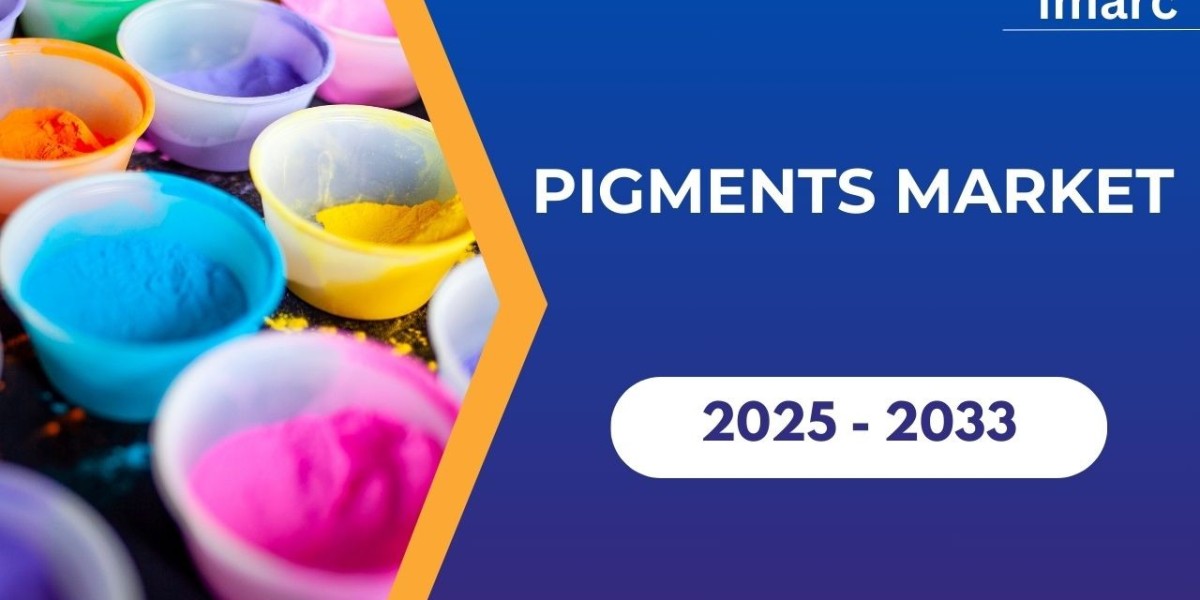MARKET OVERVIEW:
The global pigments market, valued at USD 31.4 billion in 2024, is expected to reach USD 59.6 billion by 2033, growing at a CAGR of 7.02%. The market is primarily driven by increasing demand for high-quality paints, including those with metallic finishes, and rapid industrialization, particularly in the Asia Pacific region. Additionally, the growing consumer preference for eco-friendly pigments and advancements in technologies like digital printing and nano-pigments is further shaping market dynamics.
STUDY ASSUMPTION YEARS:
- BASE YEAR: 2024
- HISTORICAL YEAR: 2019-2024
- FORECAST YEAR: 2025-2033
PIGMENTS MARKET KEY TAKEAWAYS:
- The global pigments market is expected to grow from USD 31.4 billion in 2024 to USD 59.6 billion by 2033, with a CAGR of 7.02%.
- The market is seeing increased demand for organic and eco-friendly high-performance pigments (HPPs).
- Strong growth in the Asia Pacific region due to rapid industrialization and adoption of HPPs in various industries.
- The shift towards sustainable manufacturing and low-toxicity pigments is creating new growth opportunities.
- Increasing applications in textiles, packaging, paints, and coatings industries.
- Innovations in digital inks and nano-pigments are boosting market potential.
- Rising consumer demand for more durable, chemical-resistant pigments fuels market development.
MARKET GROWTH FACTORS:
Technological Advancements in Pigments Production:
Advanced pigment technologies, especially in the form of nano-pigments, have facilitated the growth of the market. These innovations give improved performance, higher color precision, and durability. Research in 2023, conducted by Zentek Ltd, indicated that graphene-based nano-pigments are promising candidates in chromate-free and corrosion-resistant aerospace paints. Similarly, companies like BASF are pursuing greener methods of pigment production, focusing on water-based products to reduce VOC emissions. Such technological progress pushes performance while accommodating growing environmental and regulatory concerns, hence boosting the market.
Demand for Eco-Friendly and Sustainable Pigments:
An important driver for pigment sales is the increasing demand for sustainable, eco-friendly products. With environmental regulations getting stronger, manufacturers are focusing on the production of pigments that minimize toxicity and environmental impact. High-performance pigments (HPPs) are steadily gaining popularity due to their increased durability, chemical resistance, and fastness properties, especially in coatings and plastics. In the face of market demand, just as consumers and industries alike call for greener products, manufacturers can also offer biodegradable, carbon-negative, and water-based pigments, further boosting market growth.
Growth in End-Use Industries:
High growth in the pigment market is supported by increased consumption in various sectors, such as paints and coatings; construction materials; plastics; and packaging. The rapid growth of the construction industry, especially in emerging economies, is raising the demand for pigments in paints and coatings to be used for protective and aesthetic applications. The same is furthered by the growing packaging industry, which requires brighter and richer colors in packaging materials. Moreover, advancements in digital printing methods and high-grade inks have opened additional avenues for using pigments in textiles, graphics, and sales materials, adding further thrust to the market.
MARKET SEGMENTATION:
- Breakup by Product Type:
- Organic Pigments: Derived from carbon-based molecules, these pigments offer vibrant colors and are increasingly used in paints, coatings, and printing inks.
- Inorganic Pigments: Known for their stability and durability, these pigments are often used in industrial applications such as automotive coatings and construction materials.
- Specialty Pigments: These pigments are used in high-end applications, offering unique colors and performance properties, including metallic finishes and glow-in-the-dark effects.
- Breakup by Color Index:
- Reds: Frequently used in coatings, plastics, and textiles, red pigments are in high demand due to their bold and attention-grabbing colors.
- Orange: Used in industrial coatings and plastics, orange pigments provide vibrant hues with good heat resistance.
- Yellows: Common in coatings, inks, and packaging, yellow pigments are highly valued for their bright and long-lasting appearance.
- Blue: Blue pigments are used in a variety of applications, including cosmetics and industrial coatings, due to their stability and color fastness.
- Green: Green pigments are widely used in paints, plastics, and textiles, offering excellent resistance to fading.
- Brown: Often used in coatings, inks, and construction materials, brown pigments are prized for their earthy tones and durability.
- Others: Includes various special effects pigments and hues for niche applications.
- Breakup by Application:
- Paints and Coatings: The largest segment, driven by demand in architectural coatings, automotive, and industrial applications.
- Plastics: Pigments are used in plastic products to provide vibrant color and UV protection.
- Printing Inks: Demand for high-quality pigments in printing inks for packaging, labels, and marketing materials is growing.
- Construction Materials: Pigments are increasingly used in building materials for both functional and decorative purposes.
- Others: Includes use in textiles, cosmetics, and food products.
- Breakup by Region:
- Asia Pacific
- Dominates the market due to industrialization and adoption of high-performance pigments.
- North America
- Significant demand for eco-friendly and sustainable pigment solutions.
- Europe
- Home to leading pigment manufacturers focusing on innovation and sustainability.
- Latin America
- Growing demand for pigments in construction and packaging industries.
- Middle East and Africa
- Increasing infrastructure development and industrial growth in several countries.
- Asia Pacific
REGIONAL INSIGHTS:
As rapid industrialization and high-performance pigments demand in manufacturing, construction, and packaging industries drive the Asia Pacific region to dominate the pigments market. A strong presence in the automotive and textile sectors boosts pigment consumption within the region, whereas, on the other hand, development of eco-friendly products is propelled by environmental regulations.
RECENT DEVELOPMENTS & NEWS:
Considerable strides have been made in the pigments market with the advent of eco-friendly and sustainable pigment solutions. Nature Coatings introduced BioBlack, a bio-based pigment made from recycled wood waste, in 2024. Meanwhile, BASF and Zentek Ltd are furthering eco-friendly pigment production and utilizing nano-pigments for specialized applications, like in aerospace coatings. Digital inks are also expanding, spearheaded by market leaders DS Smith and MS Printing Solutions, into high-end digital printing applications.
KEY PLAYERS:
- BASF SE
- Cabot Corporation
- Dainichiseika Color & Chemicals Mfg. Co. Ltd.
- DIC Corporation
- Dupont De Nemours Inc.
- Heubach GmbH
- Kronos Worldwide Inc. (Valhi Inc.)
- Lanxess AG
- Merck KGaA
- Pidilite Industries Limited
- Sudarshan Chemical Industries Limited
- The Shepherd Color Company
- Tronox Holdings PLC
If you require any specific information that is not covered currently within the scope of the report, we will provide the same as a part of the customization.
About Us:
IMARC Group is a global management consulting firm that helps the world’s most ambitious changemakers to create a lasting impact. The company provide a comprehensive suite of market entry and expansion services. IMARC offerings include thorough market assessment, feasibility studies, company incorporation assistance, factory setup support, regulatory approvals and licensing navigation, branding, marketing and sales strategies, competitive landscape and benchmarking analyses, pricing and cost research, and procurement research.



